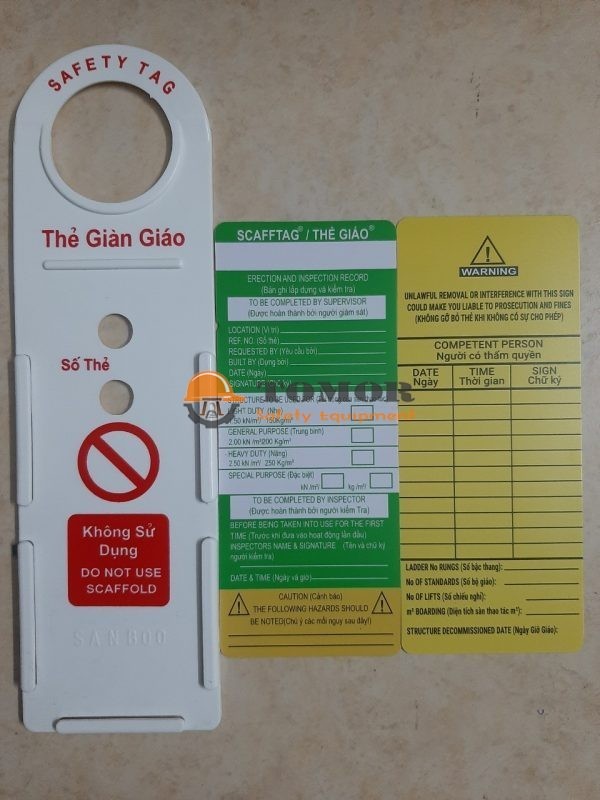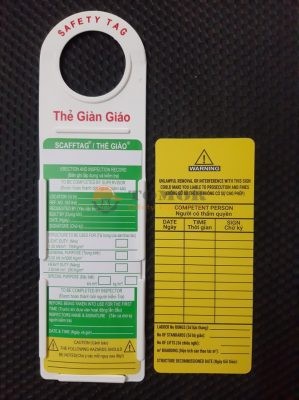Tài liệu
Tại sao phải sử dụng thẻ treo giàn giáo
Health and Safety Executive (HSE) – cơ quan sức khỏe và an toàn vương quốc Anh Nêu Rõ.
Mặc dù hệ thống thẻ không phải là một yêu cầu pháp lý, luật pháp yêu cầu kiểm tra giàn giáo từ đó một người có thể rơi từ 2 mét trở lên và vấn đề báo cáo của người có thẩm quyền, khi hoàn thành và ít nhất là hàng tuần sau đó.
Một đánh giá rủi ro có thể tìm thấy sự cần thiết phải kiểm tra giàn giáo thường xuyên hơn. Kiểm tra cũng có thể được yêu cầu sau khi thời tiết xấu và luôn luôn sau khi sửa đổi.
- Sử dụng hệ thống thẻ treo giàn giáo hiển thị để bổ sung cho các báo cáo kiểm tra là một cách hữu ích để đảm bảo những người cần truy cập vào giàn giáo biết rằng nó đã được kiểm tra và an toàn khi sử dụng.
- Giàn giáo phải được thiết kế, dựng lên, thay đổi và tháo dỡ chỉ bởi những người có thẩm quyền và công việc phải luôn được thực hiện dưới sự chỉ đạo của người giám sát có thẩm quyền.
Dịch bởi GOOGLE.Quy định của OSHA - occupational safety and health adminitration.
- June 24, 1992
- John Palmer, Director
Scaffold Training Institute
1706 Center Street Deer
Park, Texas 77536-0067 - Dear Mr. Palmer:
- This is in response to your April 6 letter requesting a clarification of the Occupational Safety and Health Administration policy for warning tags on scaffolds. I apologize for the delay of this response.
- Presently, there is no requirement that warning tags be placed on all scaffolds while they are being erected. Although there are instances where such tags are appropriate and a citation under 29 CFR 1926.200(h)(1) could be issued, there are also many instances where such would not be appropriate. An example of the latter is where a large scaffold is being built in phases or sections, employee access to the completed sections of the scaffold would not be prohibited. A tag which limits access to erection and disassembly crews on that portion of a scaffold being changed could be appropriate but a case by case determination is necessary.
- I believe this is what the compliance officers meant when they indicated to you that they are in agreement and “might even use 200(h)(1) for a citation if the situation warranted”.
- If you have further questions, please contact [Mr. Noah Connell] of my staff in the office of Construction and Maritime Compliance Assistance at [(202) 219-7207].
- Sincerely,Patricia K. Clark, Director
Directorate of Compliance ProgramsApril 6, 1992 - Mr. Roy Gurnham,
Office of Construction & Maritime
Compliance OSHA
200 Constitution Avenue N.W.
Room N 3610
Washington, D.C. 20210 - Dear Mr. Gurnham,
- I am writing to introduce myself and ask for a clarification on an issue.
- I teach courses in Scaffolding Safety to various contractors, industrial plants and other scaffolding users.
- One of the issues that frequently comes up in class is that of putting a tag on the scaffold. My recommendations to our students is that a warning tag be placed on the scaffold while it is being erected because it is only partially complete and may not have all appropriate safety features installed.
- After the scaffold is complete and final inspection is done, I recommend that a green “OK” tag or some other type of sign off sheet be placed on the scaffold to indicate that it is ready for use.
- This is a widely accepted practice in industrial plants and tagging systems (including warning tags) are available from a variety of sources.
- Many students ask me, “Is this required by OSHA?”
- My answer is yes. My explanation is that 29 CFR 1926.200(h)(1) requires warning tags to be placed on any existing hazard such as a defective tool or equipment. A partially erected scaffold may not have guardrails, or ladders, and be properly tied or be fully planked. Therefore, it would be a hazard and fall under the defective equipment category until the scaffold is completed and all safety features installed. Consequently, a warning tag should be used.
- Several compliance officers I have discussed this with have indicated that they are in agreement and might even use 1926.200(h)(1) for a citation if the situation warranted.
- However, since my students like to see clarifications in black and white, I would appreciate a written response from your office.
- Thank you for your time.
- Sincerely,John Palmer, Director
Scaffold Training Institute


